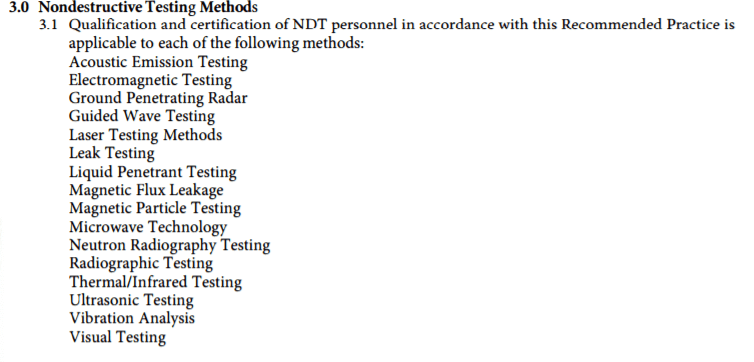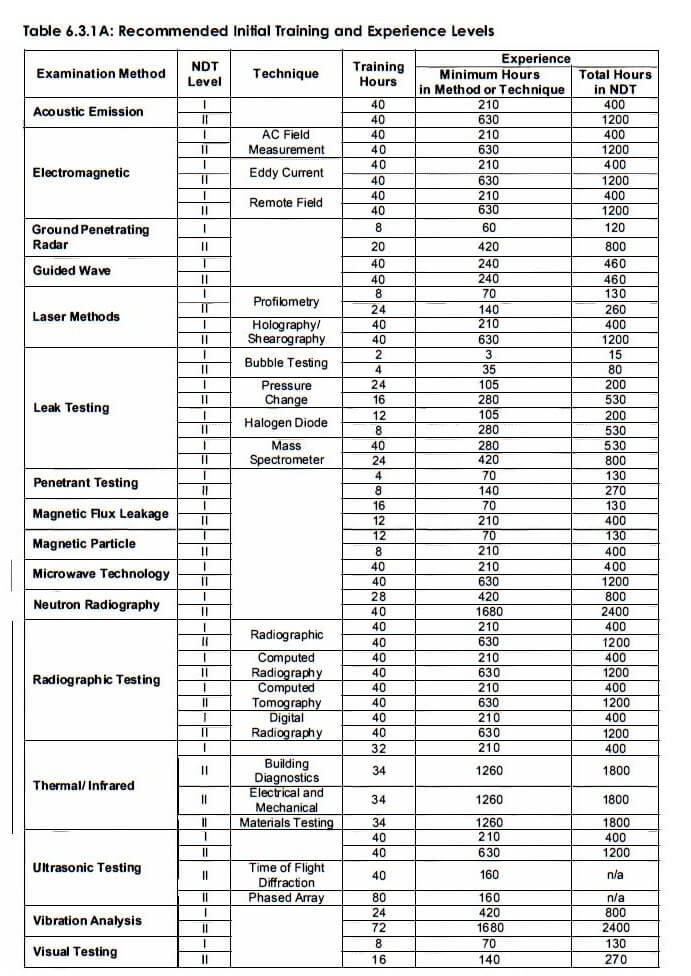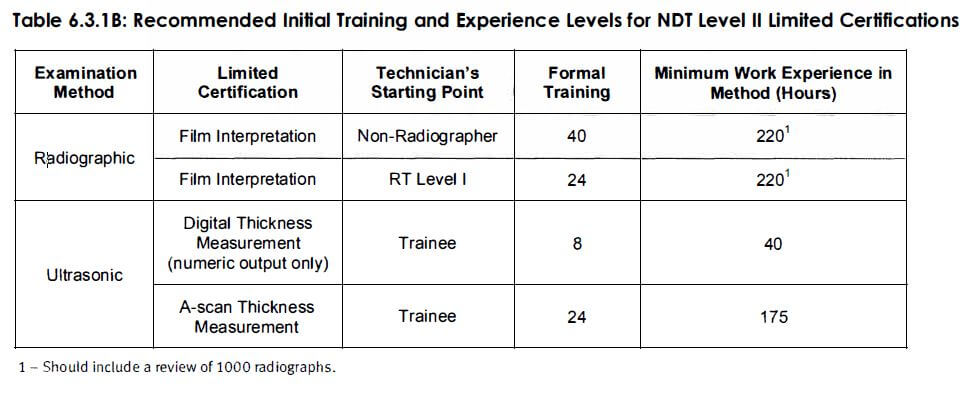Need for Certification and Qualification
Certification and qualification of NDT Engineer provide a level of confidence in the skills and competency of the NDT personnel.
As per ASNT NDT Handbook
Qualification demonstrates that an individual has the required training, experience, knowledge, and abilities;
Certification provides written testimony that an individual is qualified.
The American Society for Nondestructive Testing, Inc. or ASNT is a technical society for nondestructive testing (NDT) professionals.

ASNT SNT-TC-1A, the document for the qualification and certification of NDT personnel is recommended practice for different levels of certification in different NDT methods.

Levels of Certification:
Basically there are three different levels of certification which are
NDT Level I:
An individual having sufficient technical knowledge and skills to be qualified to properly perform specific calibrations, specific NDT, and specific evaluations for acceptance or rejection determinations according to written instructions and to record results.
The NDT Level I receives the necessary instruction and supervision from a certified NDT Level II or III individual. NDT level l can only perform tests but don’t have the authority to interpret test findings and to sign/issue test reports
NDT Level II:
An individual with sufficient technical knowledge and skills to be qualified to set up and calibrate equipment and to interpret and evaluate results with respect to applicable codes, standards, and specifications.
The NDT Level II should be thoroughly familiar with the scope and limitations of the methods for which qualified and should exercise assigned responsibility for on-the-job training and guidance of trainees and NDT Level I personnel. The NDT Level II is authorized to interpret test findings and sign/issue test reports.
NDT Level III
An individual with sufficient technical knowledge and skills to be capable of developing, qualifying, and approving procedures, establishing and approving techniques, interpreting codes, standards, specifications, and procedures; and designating the particular NDT methods, techniques, and procedures to be used.
The NDT Level III is responsible for the NDT operations for which qualified and assigned and should be capable of interpreting and evaluating results in terms of existing codes, standards, and specifications.
NDT Level III is authorized to train and certify NDT Level I, II, and III Personnel only in methods he/she is certified as NDT Level III and approve the test procedures.
Education, Training, and Experience Requirements for Initial Qualification
Candidates for certification in NDT should have sufficient education, training, and experience to ensure qualification in those NDT methods in which they are being considered for certification.
For NDT Level I and II
There is no specific education requirements like you have to hold a 10 + 2 in science or diploma in engineering fields or some bachelorette degree a person with any education background can get certified as NDT Level I and II because as per ASNT SNT-TC-1A in order to get certified as NDT level I and Level II you just need to meet the recommended training and experience hours provided in
Table 6.3.1 A lists the recommended training and experience hours to be considered by the employer in establishing written practices for the initial qualification of NDT Level I and Level II individuals.

Table 6.3.1 B lists initial training and experience hours, which may be considered by the employer for specific limited applications as defined in the employer’s written practice.

Limited Certification:
Nondestructive test methods may be further subdivided into limited Disciplines or techniques to meet specific employer’s needs; these are NDT Level II certifications, but to a limited scope for example in Ultrasonic testing, ultrasonic thickness measurement, and A-scan thickness measurement while in RT limited certification is for film interpretation with and without RT level 1 certification.
NDT Level III
In order to get certified as NDT level III one must have a baccalaureate degree (or higher) in engineering or science, plus one additional year of experience beyond the Level II requirements in NDT in NDT method(s),
or:
if one doesn’t have a baccalaureate degree one get certified if he/she has completed at least two years of engineering or science study at a university, college, or technical school, with passing grades, plus two additional years of experience beyond the NDT Level II requirements in applicable NDT method(s),
or:
if one doesn’t fully fill any of the above-mentioned criteria he/she can get certified after having four years of experience beyond the NDT Level II requirements in applicable NDT method(s).
Moreover, for NDT Level III certification the experience should consist of the sum of the hours for NDT Level I and Level II.
Training Programs:
All training programs must be approved by the NDT Level III responsible for the applicable method. Personnel being considered for initial certification should complete sufficient organized training that may include instructor-led training, personalized instruction, virtual instructor-led training, computer-based training, or web-based training.
Examination:
NDT Level III is responsible for the administration and grading of examinations. NDT Level III approves All qualification examination questions for the applicable method.
Examination for level I & II consist of
General – address the basic principles of the applicable method.
Specific – address the equipment, operating procedures, and NDT techniques
Practical – to demonstrate familiarity with and ability to operate the necessary NDT equipment, record, and analyze the resultant information to the degree required using a flawed specimen or component.
Passing Criterion– Candidate must score 70 % in each of the above three examinations and at least 80% composite grade(average score of all three examinations must not be less than 80%).
Vision Examination:
Near-Vision Acuity: The examination ensures natural or corrected near-distance acuity in at least one eye such that the applicant is capable of reading a minimum of Jaeger Number 2 or equivalent type and size letter at the distance from the chart but not less than 12 in. (30.5 cm) on a standard Jaeger test chart.
Color Contrast Differentiation.: This examination demonstrates the capability of distinguishing and differentiating contrast among colors or shades of gray used in the method as determined by the employer. It is conducted upon initial certification and at five-year intervals thereafter.
Note: Vision examinations expire on the last day of the month of expiration.
Recertification is carried out at intervals of 5 years.
Conclusion:
Simply if you want to opt NDT as a career look for some reputed institute that can provide you training and certification. NDT level III will train and certify you. The training period can be between 4-15 Days depending on the test method. At the end of the training, NDT Level III conducts the exam and eye vision test. Once you have cleared exam NDT level III will certify you on the basis of your training and exam results.
My personal advice to you is that don’t go for NDT Level I instead directly go for NDT Level II since it will provide you a good hike in skill sets and authorities and better career options.
Suggestions
It is not necessary that you get certified as NDT level I first and after the required experience, hours get certified as NDT level II. One can directly get certified as NDT level II provided the recommended training and experience consists of the sum of the hours recommended for NDT Level I and Level II.
It is not necessary for you to have a science background to get certified as NDT level I, II or III. Still, I will suggest it is better to get certified after having a diploma in engineering or a Bachelorette’s degree. It will help you to understand the NDT principles providing good career growth in the field of NDT. Since in certain certifications it is mandatory to have a bachelorette degree or diploma in engineering.
All the Best.


Very good article, hi. I hope you will print again sort of post.
Thank you!
King regards,
Mead Hessellund
Like!! Great article post.Really thank you! Really Cool.
I really like and appreciate your article post.Really looking forward to read more. Will read on…
Muchos Gracias for your article post.Really thank you! Fantastic.
This is one awesome blog post.Really thank you! Want more.
A big thank you for your blog post.Really looking forward to read more. Really Great.
Really appreciate you sharing this blog post.Much thanks again. Cool.
Really enjoyed this article post. Fantastic.
Enjoyed every bit of your blog post.Much thanks again. Great.
Really enjoyed this article post.
Pingback: Introduction to Casting Process | World Of NDT
Pingback: NDE procedures for welds in B31.3 | World Of NDT